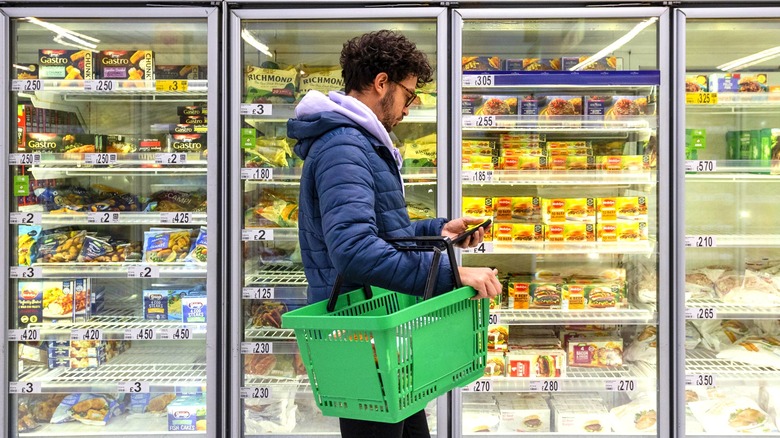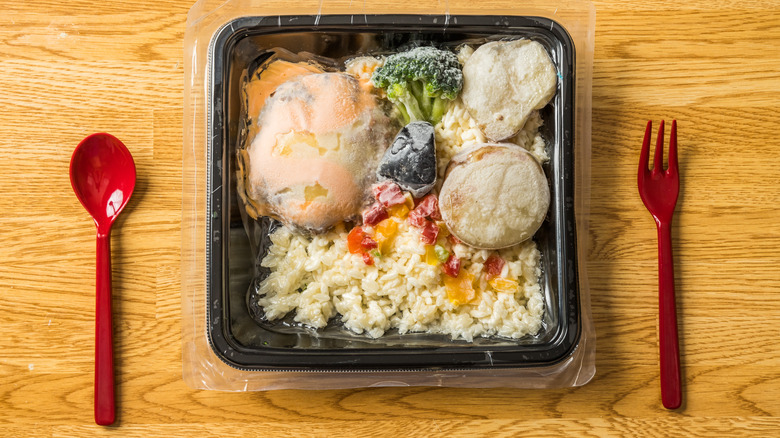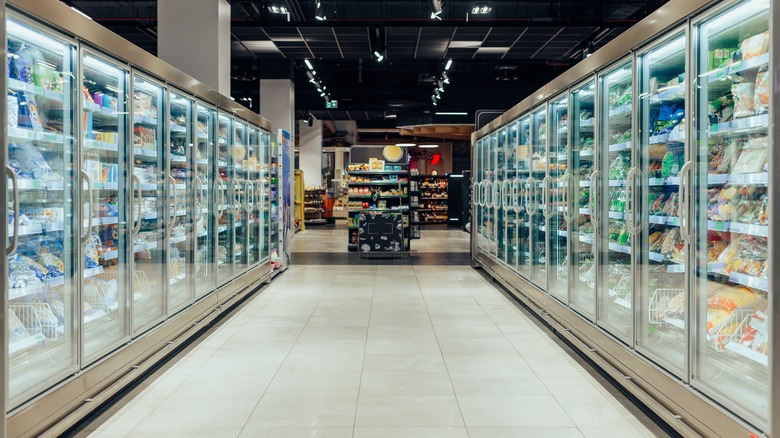The Little-Known Origin Of The Frozen Food Industry
These days, more people than ever rely on their freezers to prepare meals quickly and efficiently, and grocery store freezer aisles are packed with ready-made dishes and ingredients from around the world. Freezing food to 0 degrees Fahrenheit prolongs its shelf life by halting the growth of microorganisms, such as bacteria and mold. This basic method is not new; people have been freezing their food in naturally occurring ice since the time they began hunting and gathering. In fact, the world's first frozen foods date back thousands of years, with ancient Chinese people using ice caves for food preservation as early as 3000 B.C.
However, there's a significant difference between ancient simple freezing methods for storing produce in cold climates and the fast-growing, international frozen food industry we see today. While many credit a man named Clarence Birdseye with pioneering the modern frozen food industry in the 1920s, its roots actually extend further back. Frozen meat began being transported from Australia and Russia to England in the 19th century, but it was the Baerselman Bros. company that laid the groundwork for the modern industry in the late 1890s.
The frozen food shipping business began in the 1800s
The process of transporting frozen food began on a small scale in the mid-19th century. The New South Wales Fresh Food and Ice Company started trialing shipments of frozen meat from Sydney to London in 1868, and a Russian company began shipping a small amount of frozen poultry to London in the late 1800s.
In 1899, the Baerselman Bros. company began using the method of delivering frozen produce in insulated containers on a larger scale, shipping 20,000 frozen geese and chickens to the English capital. Initially a seasonal winter business, it began to expand. However, the frozen food industry was yet to take off commercially.
A major hurdle was that frozen produce didn't retain the same quality after thawing as when fresh. This was partly due to slow freezing speeds, as well as packaging and transportation issues. The slow freezing process allowed ice crystals to develop, affecting taste and texture (a phenomenon now known as freezer burn). But in the 1920s, Clarence Birdseye developed a new method of fast-freezing that went on to revolutionize the industry.
The frozen food industry is still evolving
Clarence Birdseye, a Brooklyn native, learned about freezing food when he was sent to Labrador in Newfoundland in 1917. There, he was taught to fish under thick layers of ice by the local Inuits. Noticing how quickly the fish froze in the ice and that they tasted fresh and retained their texture once thawed, Birdseye was inspired.
Back in New York in 1924, Birdseye created the "Quick Freeze Machine," leading to the establishment of the now ubiquitous frozen food brand, Birds Eye. The industry continued to expand rapidly in subsequent years, marked by the arrival of the Swanson "TV Dinner" in the 1950s, the growth of supermarkets, the development of new technologies, and the increasing prevalence of home freezers.
As the demand for convenience in purchasing, storing, and preparing food grows, the frozen food industry continues to expand and evolve. This includes a broader range of international cuisines in grocery store frozen aisles, as well as an increased demand for organic and plant-based products. Particularly, vegan and meat-free frozen foods are driving market growth, illustrating a significant evolution from the basic frozen fowl of the late 1800s.
The history of grocery store freezers
While Clarence Birdseye revolutionized the modern frozen food industry with his method of flash-freezing in the 1920s, he also played a pivotal role in how frozen food was transported and stored in subsequent decades, including the development of the freezer cases we see in grocery stores today.
In 1928, Birdseye created the double belt freezer, laying the groundwork for modern freezers. According to "Birdseye: The Adventures of a Curious Man" by Mark Kurlansky, when Birdseye's new company, Birds Eye, was gearing up for its 1930 launch in Springfield, Massachusetts, it equipped a few local stores with frozen display cabinets valued at $1,500. This price was prohibitively high for most family-owned stores. Additionally, these freezers were costly to operate and required regular maintenance by teams of mechanics. Due to these challenges, freezer availability remained limited in most grocery stores; by 1933, only 516 retail stores in America offered "frosted food," as it was then called.
In 1934, Birds Eye commissioned American Radiator Corp to design a more affordable display case for frozen foods, costing $300 and cheaper to operate. In 1944, the company began leasing refrigerated boxcars, enabling frozen foods to be distributed and sold on a wider scale. Post-World War II, as people began to buy refrigerators with freezer compartments for their homes, the popularity of buying frozen food really took off.




